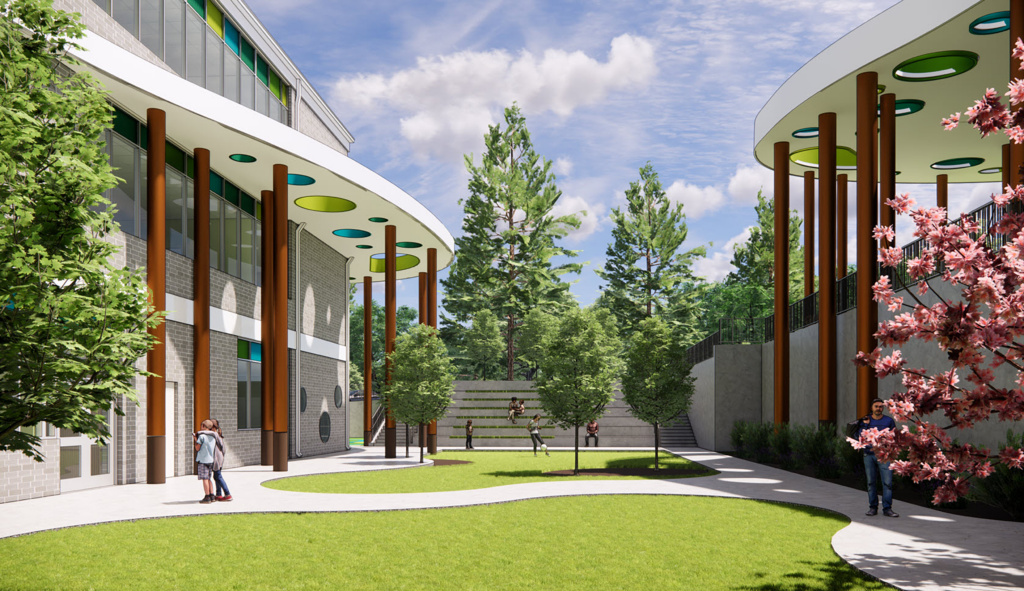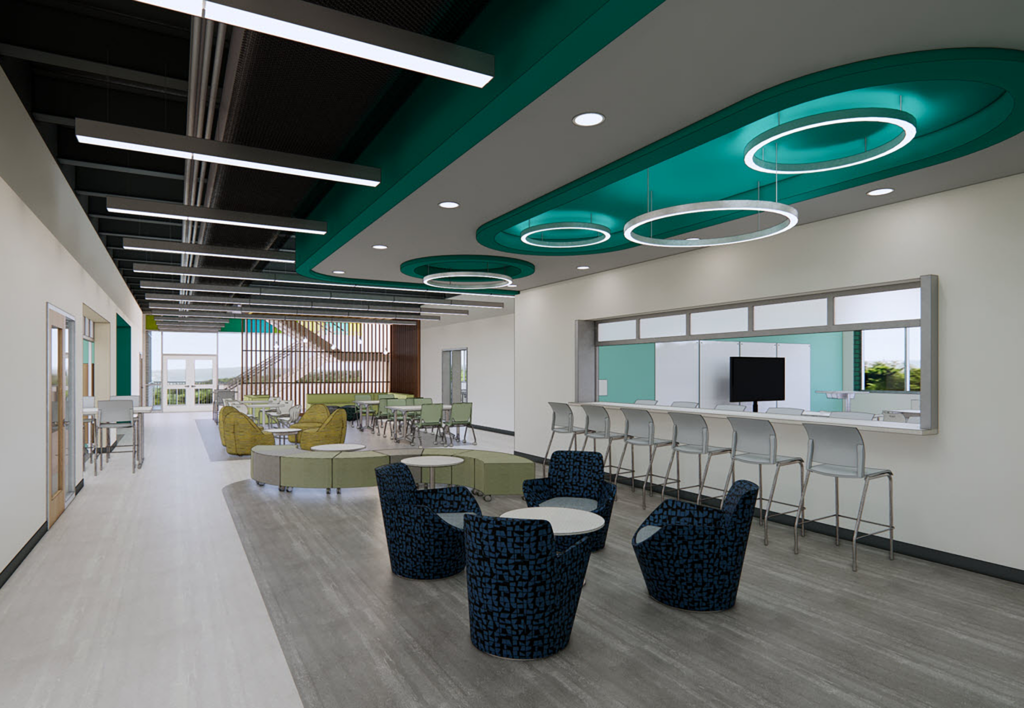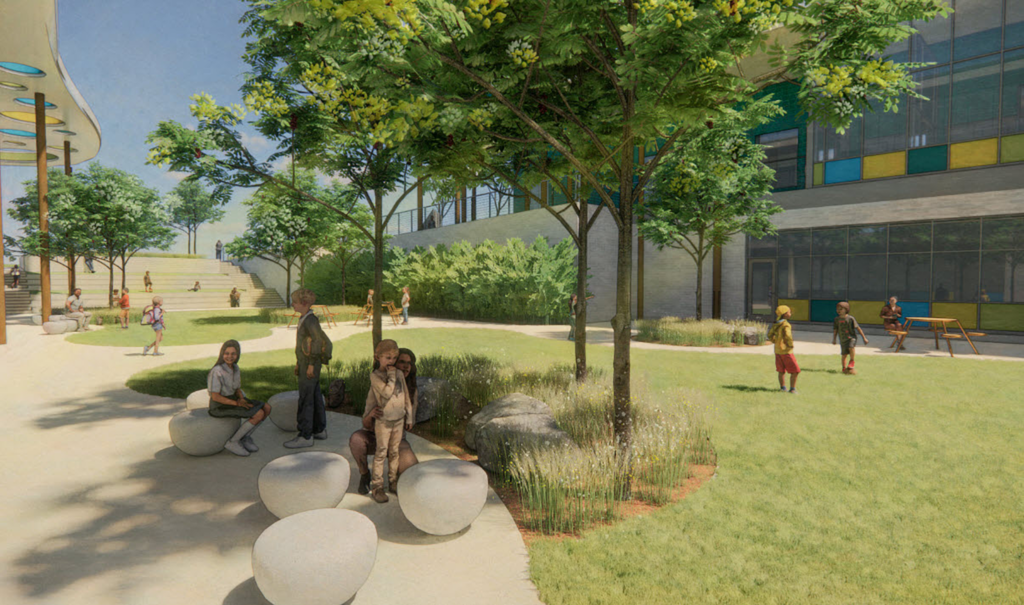What happens when the tenets of a unique instructional pedagogy drive an innovative architectural design? This inspiration is behind the design for the new Peck K-8 school in Greensboro, North Carolina. While the doors have not yet opened at the new Expeditionary Learning (EL) school, the dream is that the building amplifies the learning experience for students and supports academic outcomes, character building, and high-quality work through the school’s partnership with EL Education. Once constructed, the new Peck K-8 facility will support pedagogy and schoolwide best practices rooted in exploration, curiosity and creativity.

The existing Clara J. Peck Elementary School, built in 1929, holds much history and served students well for many years. When the new facility opens in the fall of 2024 (anticipated), it will open both as a new school facility and in a new partnership with EL Education. This new facility, through the innovative design and architecture of SHP, will result in a modern structure that replaces an aging school in desperate need of repair. It will also create a unique learning environment designed intentionally to support student learning.
Background and Rationale
The community and citizens of Guilford County approved a $300 million bond in 2020 that demonstrated their commitment to the students in Guilford County and to the diverse students at Peck Elementary School. The need to replace the aging school facility and reimagine what education can and should be guided the district’s decision to partner with EL Education for the new school model. This presented an opportunity to design a school with intentionality around the specific needs of the learners the school would serve.

Expeditionary Learning, like other forward-thinking educational models, is rooted in a student-centered environment that promotes creativity, innovation, collaboration, critical thinking and problem-solving. But EL has several key differentiators. EL students are grouped into a CREW, a tightly knit family of teachers and students that remains together every year until they leave school. EL students also learn by conducting learning expeditions. These can be within the school or out in the community.

Across the country, educators, policymakers and parents are looking for ways to support students as they overcome learning losses from the pandemic. EL Education is a national non-profit organization that partners with K-12 schools and districts to help them realize high levels of equitable outcomes not only in academics but also in the development of character and high-quality work. They offer a different approach to school improvement and have the results to prove that it works. They engage students so they become self-motivated learners. EL inspires teachers and gives them the strategies they need to make a difference in their student’s achievement. And they give communities tools to help their schools prepare young people for success. To learn more about EL Education, please visit www.eleducation.org.
EL Education highly values students as leaders of their own learning.
Because of the project-based nature of the EL model, school spaces need to be intentionally designed to be agile to allow for different configurations of students to work together and with their teachers. In addition, EL Education highly values students as leaders of their own learning. Consequently, EL students require environments that encourage discovery and deeper learning. Highly flexible spaces enable teachers to more easily calibrate their processes and students to make overt connections between subject area content and skills.
Process

The design team at SHP initially engaged in professional learning with EL Education. Their attendance at the EL Education Virtual Summit in 2021 provided an opportunity for the design team to better understand EL Education’s vision and school partnership model. EL Education staff attended many of the initial design meetings to provide consultation and expertise related to aspects of the facility that would enhance the curriculum and practices that would be taught. When stakeholders in the Peck community were asked what kind of school they wanted for Peck students, SHP architects presented elements of EL Education that would be incorporated into the design. Some examples are:
- Improving achievement by enabling students to be problem solvers, critical thinkers, and active citizens;
- Fostering students as leaders of their own learning;
- Facilitating long-term investigations (learning expeditions) of important topics that mirror real-world challenges.
Teachers at the current Peck Elementary School have been engaged in professional development with EL Education since 2021. This learning aims to ensure they are equipped with background knowledge of the instructional and cultural components of being an EL Education partnership school. This familiarity will be a springboard to understanding how the school’s design was inspired and provides facility elements that enhance the work they will be doing with students.

During the design process, SHP emphasized elements that could be specifically drawn from a discovery center at the heart of the school, where students can engage with traditional and digital media resources while also serving as a space. While adjustments were made to the overall design through iterative revision, the design remains authentically derived from EL Education’s emphasis on creativity, discovery, student ownership and authentic learning. Physical spaces were designed to correlate with and enhance the learning inside the school directly.
Outcomes
Rather than the planned building architecture subtly integrating these elements into the design, they intentionally point back to the collaboration between the school district’s vision for instructional spaces in concert with the emphasis on active learning and collaboration. The new Peck K-8 school integrates physical environments with EL Education’s whole school model:

- The exterior of the building and interior spaces incorporate elements of nature, emphasizing curiosity and intentionally bringing the landscape of the land on which the facility is built into harmony.
- Markerboards and display boards throughout classrooms and hallways provide an opportunity for students to display their work for their classmates to review, critique and revise. Persistence will be on display as visitors, staff, students and families walk through classrooms and hallways.
- Flexible, distributed dining emphasizes the positive school culture and collaborative spirit of students in EL Education schools.
- A Maker Space will provide students with a space dedicated for critical thinking and problem-solving.
- A discovery center at the heart of the school, will enable students to engage with traditional and digital media resources while also serving as a space for research and discovery for learning expeditions.
- Garage doors and moveable walls emphasize opportunities for students to communicate, not only with their classmates but with other students and staff and engage in strategic collaboration designed to foster student engagement and authentic learning.
- The absence of teacher stations in classrooms promotes an emphasis on student ownership of their learning and independence rather than a focus on teacher-directed instruction.
- Moveable cubbies and flexibly arranged furniture in classrooms and hallways provide an avenue for students to work in various configurations both with and independently of their teacher.

The parallels between EL Education and the architecture of the new Peck K-8 school are many, and multiple elements were drawn specifically from the inspiration provided by EL Education’s whole school partnership model of best practices. The new school will enhance and amplify the district’s partnership with EL Education.
Building design around a unique pedagogy presents many opportunities for both school districts and architects
Conclusion and Opportunities
Like all forward-thinking pedagogies, EL Education is layered, nuanced and resists being oversimplified. When implemented to its fullest potential, in concert with intentionally designed spaces, EL fosters a lifelong love of learning in the students it reaches. After all the tests and assignments are completed, it is believed that students will grow into individuals who collaborate with their peers and who actively seek to engage meaningfully with and in their communities — creating a lasting and positive impact for generations to come.
Building design around a unique pedagogy presents many opportunities for both school districts and architects. School districts can benefit from magnet and choice school design with a specific focus around the theme, which can be attractive to families seeking a unique learning opportunity for their students. Architects can benefit from this immersive collaboration by building a deeper understanding to design future-forward environments where generations of children can flourish.
Through the collaboration with Guilford County Schools, EL Education and SHP, students at the new Peck K-8 school will be able to walk into a space designed specifically for the learning happening inside. Hands-on learning, collaboration, and discovery will be part of the fabric of learning, and with SHP’s design, these elements of EL Education’s model for “whole-school” partnerships.

